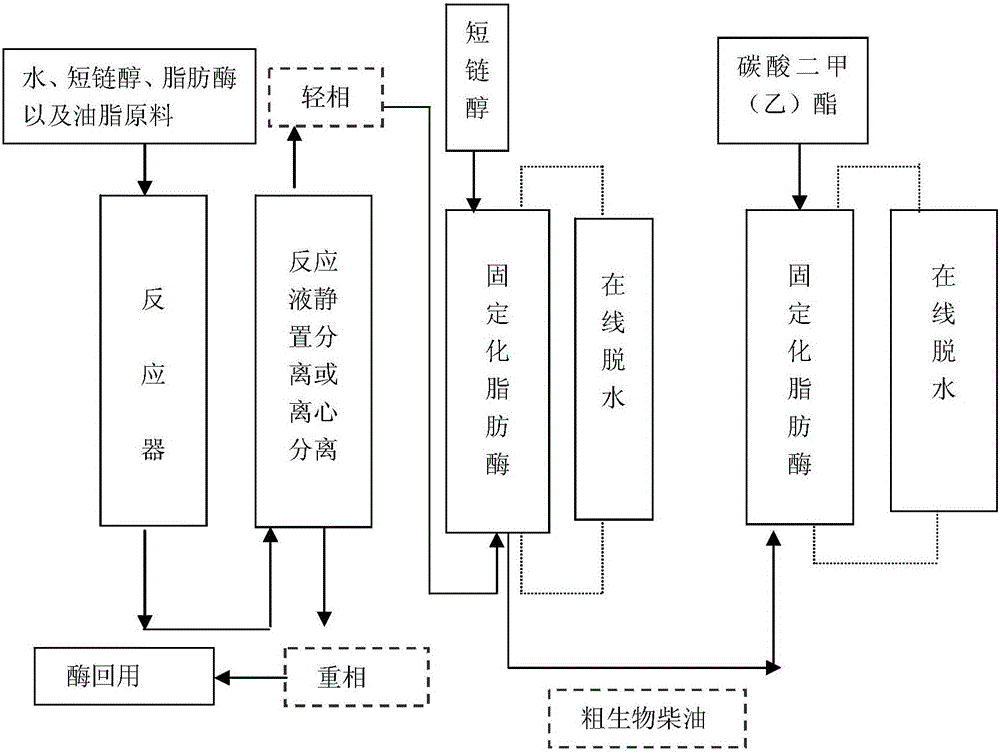Method for improving quality of biodiesel
A biodiesel and high-quality technology, applied in the direction of biofuel, fermentation, etc., can solve the problems of easy emulsion formation, increased difficulty, increased energy consumption, etc., and achieve the effect of simplifying the separation and purification process, good economic benefits and social benefits
- Summary
- Abstract
- Description
- Claims
- Application Information
AI Technical Summary
Problems solved by technology
Method used
Image
Examples
Embodiment 1
[0020] The liquid lipase derived from Candida antarctica (Candida antarctica) of 10g gutter oil, 10% water based on oil quality and 200 standard enzyme activities (200U / g soybean oil) based on unit oil quality was placed in a suitable enzyme Catalyzed one-stage or multi-stage enzyme reactors. Control the temperature at 35°C, and then add ethanol with a molar ratio of 4.5:1 based on oil at a constant speed within 3 hours. After reacting for 6 hours, the conversion rate of effective oil to biodiesel is 90%, and then the reaction liquid is left to stand for phase separation, and the heavy phase and light phase containing enzyme are separated. In the heavy phase, the enzyme protein is further recovered by membrane separation, and an organic membrane with a molecular weight cut-off of 15,000 Da is selected for the recovery of the above-mentioned lipase. The recovery rate of the enzyme protein is as high as 95%, and the residual amount of the by-product glycerol in the recovered enz...
Embodiment 2
[0022] Put 10g of lard, 4% water based on oil mass and 300 standard enzyme activities based on unit oil mass into the liquid lipase derived from Aspergillus oryzae, which is placed in a primary or multi-stage enzyme suitable for enzymatic catalysis in the reactor. Control the temperature at 40°C, and then add methanol with a molar ratio of 5:1 based on oil at a uniform rate within 4 hours. After reacting for 8 hours, the conversion rate of effective oil to biodiesel was 91%. Then the reaction solution is centrifuged to separate the heavy phase containing enzyme and the light phase containing crude biodiesel. In the heavy phase, the enzyme protein is further recovered by membrane separation, and an organic membrane with a molecular weight cut-off of 15,000 Da is selected for the recovery of the above-mentioned lipase. The recovery rate of the enzyme protein is as high as 95%, and the residual amount of the by-product glycerol in the recovered enzyme liquid is less than 5%. En...
Embodiment 3
[0024] 10g of palmitoleic acid, 5% water based on oil mass and liquid lipase derived from Thermomyces lanuginosus (Thermomyces lanuginosus) based on 200 standard enzyme activities per unit oil mass and 400 standard enzyme activities based on unit oil mass The liquid lipase derived from Aspergillus oryzae is placed in a one-stage or multi-stage enzyme reactor suitable for enzyme catalysis. Control the temperature at 45°C, and then add ethanol with a molar ratio of 6:1 based on oil at a constant speed within 2 hours. After reacting for 5 hours, the conversion rate of effective oil to biodiesel is 92%, and then the reaction solution is centrifuged to separate the heavy phase containing enzyme and the light phase containing crude biodiesel. In the heavy phase, the enzyme protein is further recovered by membrane separation, and an inorganic membrane with a molecular weight cut-off of 15,000 is selected for the recovery of the above-mentioned lipase. The recovery rate of the enzyme ...
PUM
| Property | Measurement | Unit |
|---|---|---|
| Molecular weight | aaaaa | aaaaa |
| Molecular weight | aaaaa | aaaaa |
Abstract
Description
Claims
Application Information
 Login to View More
Login to View More - R&D
- Intellectual Property
- Life Sciences
- Materials
- Tech Scout
- Unparalleled Data Quality
- Higher Quality Content
- 60% Fewer Hallucinations
Browse by: Latest US Patents, China's latest patents, Technical Efficacy Thesaurus, Application Domain, Technology Topic, Popular Technical Reports.
© 2025 PatSnap. All rights reserved.Legal|Privacy policy|Modern Slavery Act Transparency Statement|Sitemap|About US| Contact US: help@patsnap.com

